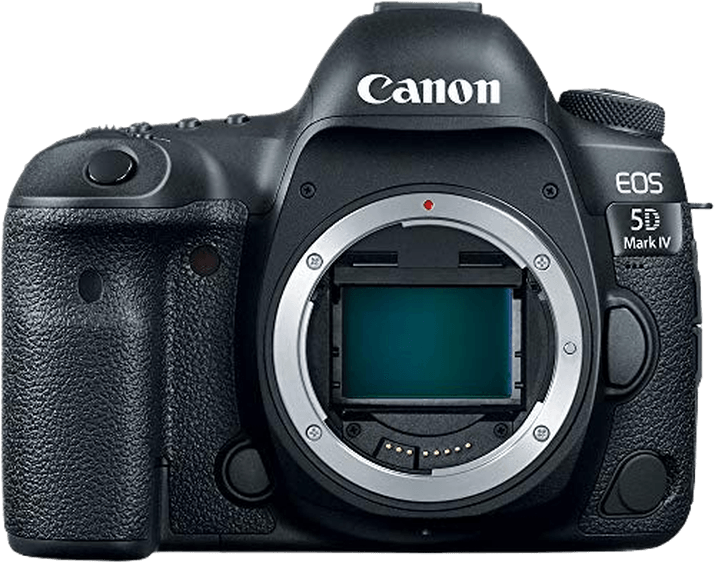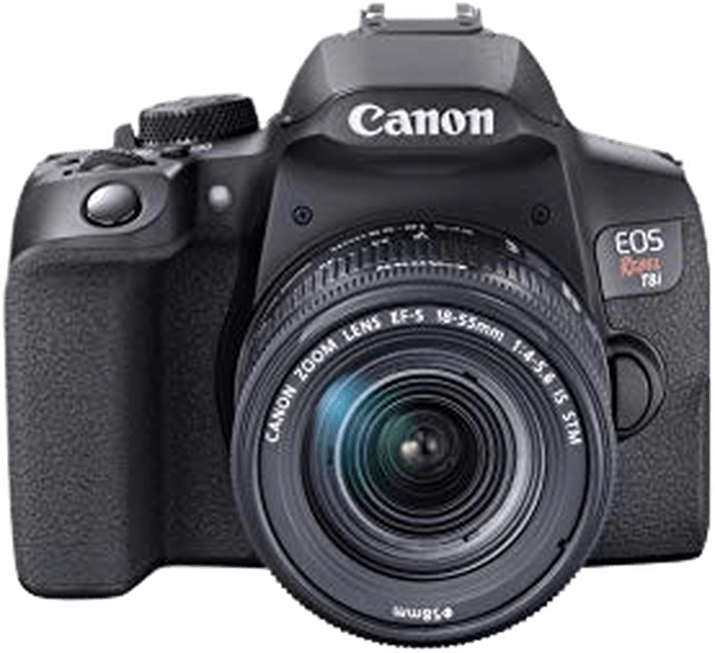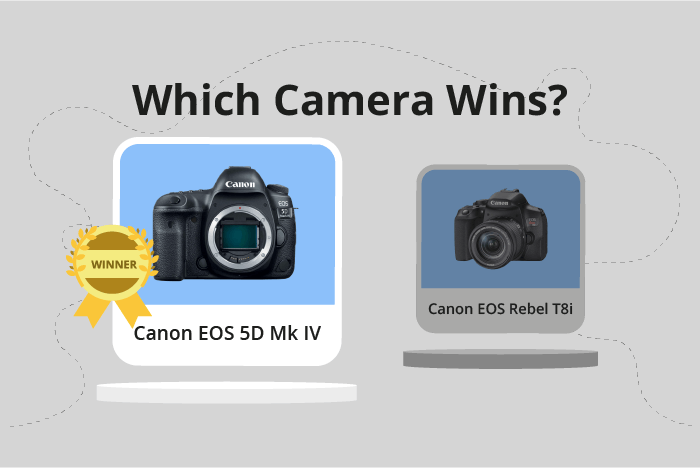Canon EOS 5D Mark IV vs EOS Rebel T8i / 850D Comparison
Canon EOS 5D Mark IV

Canon EOS Rebel T8i / 850D

The Canon EOS 5D Mark IV emerges as the winner with a score of 75/100, outperforming the Canon EOS Rebel T8i / 850D, which scored 59/100. Both cameras share some general specifications, being DSLR cameras with similar dimensions. The 5D Mark IV, however, offers superior performance with its higher score.
The 5D Mark IV’s advantages include its release date in 2016, making it a more established model, as well as its launch price of $3500, reflecting a higher-end product. Additionally, it has a larger size (151 x 116 x 76mm) and a heavier weight (890g / 1.96lbs), which may appeal to professional photographers looking for a sturdy and reliable camera.
On the other hand, the Rebel T8i / 850D, released in 2020, is a more affordable option with a launch price of $750. It also has a compact size (131 x 103 x 76mm) and lighter weight (515g / 1.14lbs), making it a great choice for those seeking a portable and budget-friendly camera.
Taking these factors into account, the Canon EOS 5D Mark IV is the better option for professional photographers, while the Canon EOS Rebel T8i / 850D is an excellent choice for hobbyists or those on a budget.
Canon EOS 5D Mark IV vs EOS Rebel T8i / 850D Overview and Optics
The Canon EOS 5D Mark IV wins the optics comparison with a score of 76/100, while the Canon EOS Rebel T8i / 850D scores 57/100. Both cameras share several specifications, including a CMOS sensor, the absence of image stabilization, and the compatibility with Canon EF lenses. However, the 5D Mark IV surpasses the Rebel T8i in several aspects, contributing to its higher score.
The 5D Mark IV has a higher megapixel count at 30.4 compared to the Rebel T8i’s 24, allowing for more detailed images. Additionally, the 5D Mark IV boasts a full-frame sensor, while the Rebel T8i has an APS-C sensor. The larger sensor size of the 5D Mark IV results in better image quality and low-light performance. Furthermore, the 5D Mark IV has a superior DXOMARK sensor score of 91, compared to the Rebel T8i’s 58, indicating a higher overall image quality.
On the other hand, the Rebel T8i has a slightly faster shooting speed of 7.5 compared to the 5D Mark IV’s 7, which could be beneficial for capturing fast-moving subjects. The Rebel T8i also features a more advanced processor, the Digic 8, while the 5D Mark IV uses the older Digic 6+ processor.
To conclude, the Canon EOS 5D Mark IV outperforms the Rebel T8i / 850D in terms of optics, primarily due to its higher megapixel count, full-frame sensor, and better DXOMARK score. However, the Rebel T8i has a marginal advantage in shooting speed and an updated processor. Ultimately, the 5D Mark IV is the superior choice for those prioritizing image quality, while the Rebel T8i may be more suitable for those seeking faster shooting speeds.
Canon EOS 5D Mark IV vs EOS Rebel T8i / 850D Video Performance
The Canon EOS 5D Mark IV emerges as the winner in the video category, scoring 91 out of 100 compared to the Canon EOS Rebel T8i / 850D’s score of 83. Both cameras share some common video specifications, including 4K video resolution and built-in time-lapse functionality. However, there are key differences that make the 5D Mark IV superior in video capabilities.
The 5D Mark IV has a higher maximum video dimension of 4096 x 2160, while the Rebel T8i / 850D’s maximum video dimension is 3840 x 2160. This difference in video dimensions means that the 5D Mark IV can capture more detailed and sharper video footage than its counterpart. Furthermore, the 5D Mark IV boasts a higher maximum video frame rate of 120fps, double the Rebel T8i / 850D’s 60fps. This allows for smoother slow-motion video playback and more creative flexibility in post-production.
On the other hand, the Rebel T8i / 850D still offers solid video capabilities despite its lower score. It shares the 4K video resolution and time-lapse functionality with the 5D Mark IV, making it a viable option for casual videographers or those on a budget. However, for those seeking professional-level video quality, the 5D Mark IV’s higher video dimensions and frame rate make it the better choice.
Comparing the video capabilities of the Canon EOS 5D Mark IV and the Canon EOS Rebel T8i / 850D, it is clear that the 5D Mark IV is the superior camera. With higher video dimensions and a faster frame rate, it provides better overall video quality and creative options. While the Rebel T8i / 850D is still a decent option for casual users, the 5D Mark IV is the recommended choice for those seeking the best video performance.
Canon EOS 5D Mark IV vs EOS Rebel T8i / 850D Features and Benefits
The Canon EOS 5D Mark IV outperforms the Canon EOS Rebel T8i / 850D with a feature score of 74/100, compared to the latter’s 70/100. Both cameras share some common specifications, such as touchscreen capabilities and WIFI connectivity. However, there are key differences that set them apart.
The 5D Mark IV boasts a larger screen size of 3.2 inches and a higher screen resolution of 1,620,000 dots, providing a clearer and more detailed display. Additionally, this camera includes GPS functionality, which the Rebel T8i / 850D lacks. This feature allows users to geotag their photos, making it easier to organize and locate images based on location data.
On the other hand, the Rebel T8i / 850D offers some advantages over the 5D Mark IV. It features a flip screen, enabling users to capture images and videos from various angles with ease. This camera also includes Bluetooth connectivity, which the 5D Mark IV does not have, allowing for seamless pairing with compatible devices for easy photo transfer and remote control options.
In terms of features, the Canon EOS 5D Mark IV emerges as the superior camera due to its larger screen size, higher screen resolution, and GPS functionality. However, the Canon EOS Rebel T8i / 850D should not be overlooked, as its flip screen and Bluetooth connectivity offer added convenience and versatility for users. Ultimately, the decision between these two cameras will depend on individual preferences and specific photography needs.
Canon EOS 5D Mark IV vs EOS Rebel T8i / 850D Storage and Battery
The Canon EOS 5D Mark IV outperforms the Canon EOS Rebel T8i / 850D in storage and battery with a score of 71/100 compared to 35/100. Both cameras accept SD/SDHC/SDXC (UHS-I compatible) memory cards and lack USB charging capabilities. However, the 5D Mark IV has two memory card slots and supports Compact Flash, while the Rebel T8i has only one slot. Additionally, the 5D Mark IV has a longer battery life, providing 900 shots with its LP-E6N battery, while the Rebel T8i lasts for 800 shots using an LP-E17 battery.
Despite its lower score, the Rebel T8i still offers decent battery life and storage capabilities for casual photographers. However, the 5D Mark IV is the clear winner for professionals and enthusiasts seeking more storage flexibility and extended battery life.
Canon EOS 5D Mark IV vs EOS Rebel T8i / 850D – Our Verdict
Are you still undecided about which camera is right for you? Have a look at these popular comparisons that feature the Canon EOS 5D Mark IV or the Canon EOS Rebel T8i / 850D:

